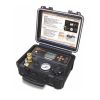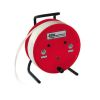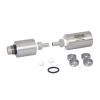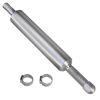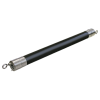Solinst Model 407 Bladder Pumps
Features
- Consistently accurate samples with excellent VOC sample integrity
- Pneumatic drive pumps are well suited for pumping contaminant liquids
- Bladders are not damaged by operation in sediment laden water, or in dry pumping conditions
- Free ground shipping
- Expedited repair and warranty service
- Lifetime technical support
- More
The Solinst Bladder Pump features a new design providing consistent, high-quality samples in all types of applications. It offers excellent performance and reliability. With Solinst Bladder Pumps, there is the assurance that there is no air/water contact during sampling. It meets the most rigorous US EPA standards for VOC groundwater monitoring.
The bladder guarantees that drive air or gas does not contact the sample, thus avoiding degassing or contamination. Solinst Bladder Pumps are rugged and long-lasting. Santoprene bladders are ideal for dedication, however, the new easy-to-replace bladder cartridges are excellent for those who prefer to change bladders after each use. The bladder and intake filters are simply replaced in the field in just a few minutes—no special tools are required.
Excellent for either regular flow or low flow sampling, the stainless steel pumps can lift from depths up to 150 m (500 ft) below grade. The new PVC Bladder Pump operates up to 100 ft (30 m) below grade.
In The News
Save our Bogs! Culture, Conservation and Climate Action in Ireland’s Peatlands
Characterized by long-term accumulation under waterlogged conditions, peatlands exist on every continent and account for 3-4% of the global land surface . Small but mighty, these often overlooked wetland environments are estimated to hold as much as one-third of the world's organic carbon in their soil—twice the amount found in the entirety of the Earth's forest biomass. While healthy peatlands can trap and store carbon, regulate water, and provide important habitats for rare species, human alteration has disturbed peatland carbon and nitrogen cycles on a global scale. Approximately 12% of the world’s peatlands have been drained and degraded through conversion for agriculture, forestry, infrastructure development, and other uses.
Read MoreSargassum Surge: How Seaweed is Transforming our Oceans and Coastal Ecosystems
Until recently, Sargassum –a free-floating seaweed–was distributed throughout the Sargasso Sea , the north Caribbean Sea, and the Gulf of Mexico. But in the space of a decade, this seaweed has, as one scientist remarks , “Gone from a nonfactor to the source of a terrible crisis.” Driven by climate change, anomalous North Atlantic Oscillation in 2009-2010 and a glut of anthropogenic pollutants, sargassum has proliferated. Seasonally recurrent mats as deep as 7m now bloom in the “Great Atlantic Sargassum Belt” (GASB), which covers areas of the Atlantic from West Africa to the Caribbean Sea and Gulf of Mexico. Every year, millions of tons wash up along the shores of more than 30 countries . Dr.
Read MoreGreat Lakes Research Center: Designing Targeted Monitoring Solutions
According to the National Oceanic and Atmospheric Administration ( NOAA ), the Great Lakes have more miles of coastline than the contiguous Atlantic and Pacific coasts combined and contain 20 percent of the world's freshwater, making it a critical region to protect and conserve. Continuous monitoring and data-informed resource management are key components of managing waters in the region. Hayden Henderson, a research engineer with the Great Lakes Research Center (GLRC), designs and deploys monitoring platforms throughout the Great Lakes. With a background in environmental engineering, Henderson enjoyed the challenge of creating systems and making them work to obtain difficult, remote measurements.
Read More























